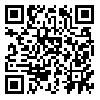Volume 9, Issue 34 (1-2021)
Haft Hesar J Environ Stud 2021, 9(34): 39-52 |
Back to browse issues page
Download citation:
BibTeX | RIS | EndNote | Medlars | ProCite | Reference Manager | RefWorks
Send citation to:



BibTeX | RIS | EndNote | Medlars | ProCite | Reference Manager | RefWorks
Send citation to:
Abeddost H, Zali N, Abizadeh S. Analysis of the role of urban graphic in the development of Razavi culture with a nostalgic approach and Icon- phenomenon (a case study of Razavi elements in Imam Reza squares in Iran). Haft Hesar J Environ Stud 2021; 9 (34) :39-52
URL: http://hafthesar.iauh.ac.ir/article-1-1170-en.html
URL: http://hafthesar.iauh.ac.ir/article-1-1170-en.html
Abstract: (2115 Views)
Introduction: Urban Graphics is one of the fields of graphic design as part of the integrated urban design activity helps to form the city's mental image. The use of statues with the theme of religious culture with metaphorical symbols and signs affects the city's overall appearance. It can be useful in institutionalizing pure Islamic values and knowledge. The field of urban graphics can illustrate Shiite religious beliefs related to the Eighth Imam and show these explicit and implicit meanings concerning Imam Reza's sanctity (PBUH) and Shiite beliefs in the urban environment. The use of religious and Shiite elements in the urban environment greatly impacts creating a sense of place and attachment. It creates the desired effects of attachment and helps the individual to go beyond the current text. This study, focusing on the analysis of the signs in the Razavi elements, tries to answer the question of what are the elements influencing the formation of meaning in the mind of the audience of the Razavi elements and how can the nostalgic approach and excellence of the mechanical icon to the phenomenon icon analyzed it.
Methodology: The research method is descriptive-analytical. The method of collecting material is a combination of library studies and field observations. Data analysis is qualitative.
Results: Razavi elements create an image of a religious place in the audience's mind, which is deeply associated with a sense of place and nostalgia for pilgrimage, which is one of the customs and social characteristics of Persian society. Razavi elements evoke the identity of a religious place. They can be considered and analyzed in terms of physical form, communication action with the audience, and the religious meaning they create in the urban space. Works designed with iconic, written, or combined signs on Imam Reza (PBUH) squares and boulevards form a process of communication with the audience. The dialogue between these signs takes place sequentially, and these signs interact with the visual perception and prior experiences of the audience.
Conclusion: The meanings of the Razavi elements or the emotion evoked by these elements are more important than their visual structure. This process can be considered the formation of a transcendent sign and its transformation into a symbol. The process of forming a religious mental image in an urban environment with the help of urban graphics can be expressed, which subsequently brings a sense of place and attachment.
Methodology: The research method is descriptive-analytical. The method of collecting material is a combination of library studies and field observations. Data analysis is qualitative.
Results: Razavi elements create an image of a religious place in the audience's mind, which is deeply associated with a sense of place and nostalgia for pilgrimage, which is one of the customs and social characteristics of Persian society. Razavi elements evoke the identity of a religious place. They can be considered and analyzed in terms of physical form, communication action with the audience, and the religious meaning they create in the urban space. Works designed with iconic, written, or combined signs on Imam Reza (PBUH) squares and boulevards form a process of communication with the audience. The dialogue between these signs takes place sequentially, and these signs interact with the visual perception and prior experiences of the audience.
Conclusion: The meanings of the Razavi elements or the emotion evoked by these elements are more important than their visual structure. This process can be considered the formation of a transcendent sign and its transformation into a symbol. The process of forming a religious mental image in an urban environment with the help of urban graphics can be expressed, which subsequently brings a sense of place and attachment.
Type of Study: Research |
Subject:
General
Received: 2021/02/3 | Accepted: 2021/01/29 | Published: 2021/01/29
Received: 2021/02/3 | Accepted: 2021/01/29 | Published: 2021/01/29
| Rights and permissions | |
 |
This work is licensed under a Creative Commons Attribution-NonCommercial 4.0 International License. |





